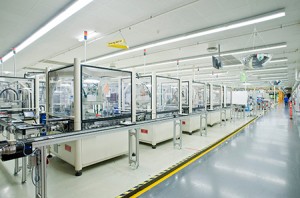What to consider when automating production processes with robots
 Anyone planning to move towards a smart factory needs to choose carefully when considering possible robotic solutions. Should it be an industrial robot or a collaborative robot (cobot)? The answer will depend on your specific needs. Experts from Omron, a leader in industrial automation, including sensing, control, vision and robotics solutions for industrial automation shed light on this topic.
Anyone planning to move towards a smart factory needs to choose carefully when considering possible robotic solutions. Should it be an industrial robot or a collaborative robot (cobot)? The answer will depend on your specific needs. Experts from Omron, a leader in industrial automation, including sensing, control, vision and robotics solutions for industrial automation shed light on this topic.
The World Robotics 2020 Industrial Robots Report has stated an 85% increase in the number of industrial robots worldwide over the past five years. And despite the pandemic, sales figures remain high. The use of robots is also broadening. Cooperation between people and robots is high on the agenda of many CEOs who want to reduce employee workloads, increase efficiency and safety, and improve processes. But how can companies know which robotics solutions to choose?
“The choice of robot will depend on the location, production focus and individual needs. The range, load capacity, movement requirements, expandability, and interaction with technologies such as artificial intelligence (AI) or image processing can all affect which robot would be best for each company,” says Fernando Vaquerizo, fixed and cobots product marketing manager at Omron Europe.
Questions to ask when automating your processes include:
- What products need to be manufactured or processed and how?
- Which movements should the robot perform?
- What distances will it need to cover?
- Should in-house experts or a machine operator control the robot?
- What type of part production and throughput is needed? (Are repeatability or precision essential?)
- Is integrated robot vision or vision for inspection required?
- Would a permanently mounted system or a flexible cobot be better?
Fixed versus flexible
Fixed-mounted robots offer high speeds, precision, re-programmability, safety and high-performance technology. However, experts are needed to reprogramme the robots, which also require significantly more space. Companies with short production cycles and throughput times might find traditional assembly robots suitable because they work faster.
Cobots on the other hand are easier to use and are ideal for high-mix, low-volume scenarios. They offer integrated safety, can cooperate with employees, and are more flexible and mobile. They are also much simpler to programme and their software is more intuitive to understand, so external specialists aren’t usually needed. They can also be mounted on top of mobile stations or mobile robots. However, to ensure safety, cobots need to work slower, especially when working in the same work envelope with people.
Finally, companies must think about the return on investment (ROI). Fixed, more complex robots usually require training and external expertise, and often need additional hardware for more extensive tasks and protection (such as light fences or cages).
Peter Lange, business development manager for fixed robotics at Omron Europe comments: “Traditional industrial robots are often more suitable for high-speed, high-precision assembly applications. Cobots are ideal for palletising, machine maintenance, material handling, machine loading, order picking, packaging and testing. They close a gap in the robotics market for applications in which the robot is more the supporting device for the operator and flexibility is more important than speed.”
The use of AI is also becoming increasingly important for real-time applications. Production lines and devices are monitored with real-time sensors, and data is collected and processed at high speed to quickly detect any anomalies.
“However, there’s no single technology that’s suitable for every application. Therefore, a detailed catalogue of requirements and fixed project goals are vital for a successful robotics project,” Lange concludes.
Visit the Omron website for more information















